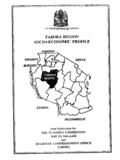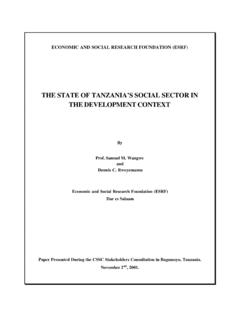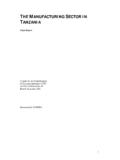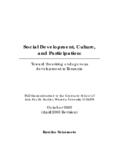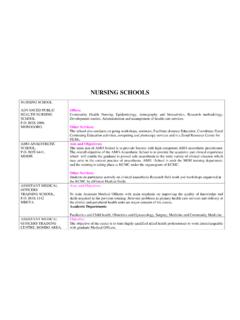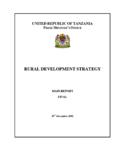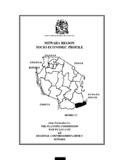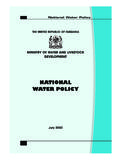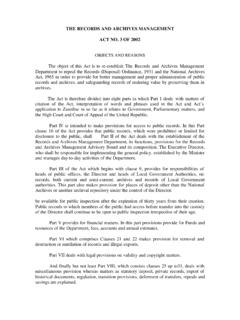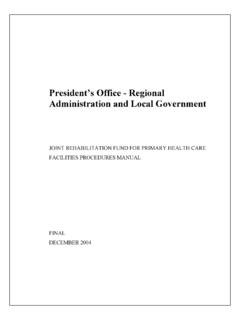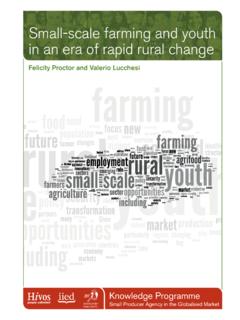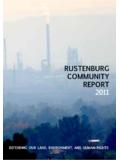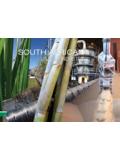Transcription of DE-AGRARIANISATION AND RURAL EMPLOYMENT …
1 DE-AGRARIANISATION AND RURAL EMPLOYMENT NETWORK. Afrika-Studiecentrum, Leiden Institute of Resource Assessment, Dar es Salaam Changing Lifestyles in Farming Societies of Sukumaland: Kwimba District, Tanzania Ndalahwa F. Madulu ASC Working Paper 27 / 1998. Copies may be ordered from: Afrika-Studiecentrum Box 9555. 2300 RB Leiden The Netherlands Fax 31-71-527-3344. Email: TABLE OF CONTENTS. Introduction 1. The Study Area 3. Kwimba District 3. Map of Mwanza Region 4. Village Characteristics 5. Agricultural Prospects and Constraints to Socio-Economic Development 11. Access to Land 12. Technological Change and Labour in Agriculture 14. Perceived Prospects for Peasant Agriculture 14. Development of Non-Farm Activities in Kwimba District 22.
2 Type of Non-Farm Activities Performed 23. People Involved in Non-Farm Activities 27. Interdependence between Non-Farm Activities and Agriculture 28. General Observations about Non-Farm Activities 30. Intergenerational Resource Transfers 30. Summary of Findings 32. Conclusion 35. References 36. Appendix : Research Methods 38. Preface This working paper provides research findings emanating from the De- agrarianisation and RURAL EMPLOYMENT (DARE) Research Programme funded by the Dutch Ministry of Foreign Affairs and coordinated by the Afrika-Studiecentrum in conjunction with African research teams from institutions in Ethiopia, Nigeria, Tanzania and South Africa. We wish to acknowledge the encouragement of Hans Slot of the Ministry of Foreign Affairs and the editorial skills of Ann Reeves for providing vital back-up for the work of the programme's research teams.
3 Despite Sub-Saharan Africa's agrarian image, the RURAL peasant population is diminishing in relative size and significance. From a multi-disciplinary perspective, the DARE has sought to dissect the process of change, drawing attention to the new labour patterns and unfolding RURAL -urban relations now taking place. The programme research theme consists of four sub-themes: economic dynamics, spatial mobility and settlement patterns, social identity adaptations and gender transformations. The objectives of the DARE programme have been to: 1) compare and contrast the process of DE-AGRARIANISATION in various RURAL areas of Africa in terms of a economic activity reorientation, occupational adjustment, social identification, and spatial relocation of RURAL dwellers away from strictly peasant modes of livelihood.
4 2) examine how risks on RURAL household production and exchange influence the extent and nature of non-agricultural activities in RURAL economies. 3) explore the inter-relationship between agriculture and the service sector in African economies; and 4) publish and disseminate the research findings to policy makers and scholars in Africa and elsewhere. The Afrika-Studiecentrum's role has been to facilitate the formulation of country case study research in various RURAL African localities by African researchers, provide a discussion forum for work-in-progress, and assist in the publication and dissemination of completed analyses of research findings. The following study by Dr. Ndalahwa Madulu is the product of collaboration between the Institute of Resource Assessment and the Afrika-Studiecentrum.
5 The specific objective of the research was to document the changing nature of land and labour allocation between different generations within RURAL households, with special emphasis on the evolution of non-agricultural labour activities. The overall findings from the DARE programme are intended to provide insight into the processes of change which are moulding the livelihood prospects of African RURAL and urban dwellers of the next century. It is hoped that the knowledge gained may be useful for formulating more effective developmental policies to assist in short-circuiting Sub-Saharan Africa's current economic and political vulnerabilities. Dr. Deborah Fahy Bryceson DARE Programme Coordinator 2. Changing Lifestyles in Farming Societies of Sukumaland:*.
6 Kwimba District, Tanzania Ndalahwa F. Madulu Institute of Resource Assessment University of Dar es Salaam This paper examines the changing lifestyle in RURAL Sukumaland. A case study of two villages in Kwimba District is used to demonstrate the nature and extent of the change in life patterns and resource control at the household level. Farming in Sukumaland constitutes an economic livelihood and a social identity. Almost everybody in the RURAL areas identifies himself/herself as a farmer. There is a widespread belief that food self- sufficiency is an important indicator of material wealth and prosperity. In other words, the value of man is in food production. Throughout Kwimba District, land is distributed at the family level through the traditional land tenure system.
7 However, land has increasingly become scarce due to population pressure and migration flows of people to other areas are on the increase. Traditionally, Sukuma investment was directed at building up livestock and farms which were a source of pride and prestige. Recent developments have necessitated both social and economic change. Among youth, for example, investment is largely directed towards better housing and trade rather than to cattle and farming. Such conditions create a conflict of interest and investment between the two generations. The attitudes of youth to farming are a clear indicator of the shrinking agricultural sector at least in terms of investments and labour allocation. This change may be influenced by many factors such as increasing levels of education, availability of alternative economic opportunities, non-sustainable agricultural conditions, resource scarcity and rapid population growth.
8 Introduction This paper examines intergenerational resource transfers, investment and lifestyle, the changing features of the household economic base and control of major factors of production (land, labour, and capital). Two villages in Kwimba District of Mwanza region in northern Tanzania are used as case studies to reflect the changing situation in Sukumaland. The hypothesis to be * Sukumaland refers to an area south of Lake Victoria. It covers the whole of Mwanza and Shinyanga and parts of Mara, Kagera and Tabora regions. The inhabitants of this area are the Sukuma, the largest group among the 120. ethnic tribes in Tanzania (Lupande 1997). Several explorers like Stanley, Speke and Burton visited Sukumaland (Meertens et al. 1995).
9 By 1948, there were 46 Sukuma chiefdoms covering an area of 16,000 square miles (Abrahams 1989, Cory 1953). 1. tested is that regions with high demographic pressures, land scarcity and restricted access to natural resources develop alternative EMPLOYMENT opportunities to absorb their growing landless populations. Historically, the Sukuma belong to the Bantu group who migrated from south of Lake Chad some 400 to 500 years ago through the Congo river basin and across Lake Tanganyika before they settled south of Lake Victoria (Malcolm 1953). At the beginning of German colonial rule (1890-1919), the Sukuma had already started agricultural intensification in response to population pressure (Meertens et al. 1995). As security was enhanced, settlements extended further from the village centres, new lands were cleared and the agricultural intensification skills adopted earlier, namely fertilisation of the soil by use of animal manure, became less necessary (Lupande 1997).
10 During British rule (1919-1961), an ambitious tsetse fly eradication campaign was implemented between 1923 and 1929 by clearing away their bushland natural habitat (Austen 1968). This campaign opened up more land for agriculture and created new tsetse-free outlets for grazing purposes. Moreover, the Sukumaland Development Scheme (SDS)1 which was in operation during the 1947-1956 period was instrumental in population resettlement. By 1952, over 30,000 people had moved to Geita District and many agro-pastoral families moved to Bariadi, Maswa and Meatu Districts (Fuggles-Couchman 1964, Malcolm 1953, Meertens et al. 1995). These resettlement programmes were the origin of Sukuma migrations which are still operating to date. Currently, Sukuma agro-pastoral families occupy large areas of land in Kagera, Tabora, Rukwa, and Mbeya regions (Charnley 1994, Kikula et al.)
